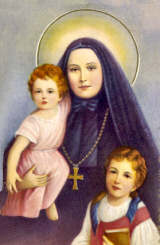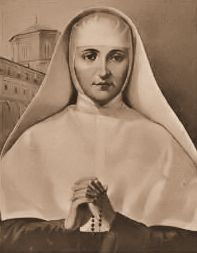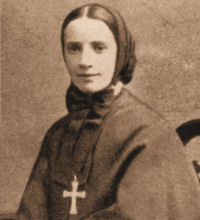Ordinary Time: November 13th
Memorial of St. Frances Xavier Cabrini, virgin (USA)
Other Commemorations: St. Agostina Livia Pietrantoni, Virgin (RM)
» Enjoy our Liturgical Seasons series of e-books!
Today the dioceses in the United States celebrate the memorial of St. Frances Xavier Cabrini, virgin, born in Lombardy, Italy, one of thirteen children. She came to America as a missionary, founded the Missionary Sisters of the Sacred Heart to care for poor children in schools and hospitals. She is the first American citizen to be canonized. December 22 is the former feast day of St. Frances Xavier Cabrini.
According to the Roman Missal of 1962 this is the feast of St. Didacus, a humble Franciscan laybrother and the recipient of exceptional graces. He received such light from God that he spoke of heavenly things in a manner almost divine; certain miracles, but especially his obedience, charity and fervor of his prayer, caused him to be considered a saint wherever he went. He was born in Andalusia, was sent as a missionary to the Canary Isles, spent some time in Rome and returned to die in Spain.
St. Frances Xavier Cabrini
 Francesca Cabrini, the first United States citizen to be canonized, was born in Italy of parents who were farmers. She was the thirteenth child, born when her mother was fifty-two years old. The missionary spirit was awakened in her as a little girl when her father read stories of the missions to his children. She received a good education, and at eighteen was awarded the normal school certificate.
Francesca Cabrini, the first United States citizen to be canonized, was born in Italy of parents who were farmers. She was the thirteenth child, born when her mother was fifty-two years old. The missionary spirit was awakened in her as a little girl when her father read stories of the missions to his children. She received a good education, and at eighteen was awarded the normal school certificate.
For a while she helped the pastor teach catechism and visited the sick and the poor. She also taught school in a nearby town, and for six years supervised an orphanage assisted by a group of young women. The bishop of Lodi heard of this group and asked Frances to establish a missionary institute to work in his diocese. Frances did so, calling the community the Missionary Sisters of the Sacred Heart. An academy for girls was opened and new houses quickly sprang up.
One day Bishop Scalabrini, founder of the Missionaries of Emigration, described to Mother Cabrini the wretched economical and spiritual conditions of the many Italian immigrants in the United States, and she was deeply moved. An audience with Pope Leo XIII changed her plans to go to the missions of the East. "Not to the East, but to the West," the Pope said to her. "Go to the United States." Mother Cabrini no longer hesitated. She landed in New York in 1889, established an orphanage, and then set out on a lifework that comprised the alleviation of every human need. For the children she erected schools, kindergartens, clinics, orphanages, and foundling homes, and numbers of hospitals for the needy sick. At her death over five thousand children were receiving care in her charitable institutions, and at the same time her community had grown to five hundred members in seventy houses in North and South America, France, Spain, and England.
The saint, frail and diminutive of stature, showed such energy and enterprise that everyone marveled. She crossed the Atlantic twenty-five times to visit the various houses and institutions. In 1909 she adopted the United States as her country and became a citizen. After thirty-seven years of unflagging labor and heroic charity she died alone in a chair in Columbus Hospital at Chicago, Illinois, while making dolls for orphans in preparation for a Christmas party. Cardinal Mundelein of Chicago officiated at her funeral and in 1938 also presided at her beatification by Pius XI. She was canonized by Pius XII in 1946. She lies buried under the altar of the chapel of Mother Cabrini High School in New York City.
—A Saint A Day, Berchmans Bittle, O.F.M.Cap.
Patronage: against malaria; emigrants (given on 8 September 1950 by Pope Pius XII); hospital administrators; immigrants; orphans
Symbols and Representation: ship; heart; book
Highlights and Things to Do:
- Read more about St. Frances Xavier Cabrini:
- Mother Cabrini's body is located in New York at the St. Frances Cabrini Shrine.
- If you live in or pass through Colorado, visit the western Mother Cabrini Shrine.
- Find out more about the religious order Missionary Sisters of the Sacred Heart that she founded. See the current website.
- Prepare an Italian dinner in honor of St. Francis Cabrini. For dessert make a ship cake (symbolizing her missionary work), a heart cake (she founded the Missionary Sisters of the Sacred Heart) or a Book Cake (symbolizing her founding a religious order). Catholic Cuisine has a few ideas for inspiration.
- Say the Little Rosary of St. Francis Xavier Cabrini.
- Cabrini Universityclosing in 2024.
- Read the Encyclical, On Consecrated Virginity, by Pius XII and if you are single consider the possibility of a vocation to this life.
- Read the Pope Benedict XVI's Address for World Day of Migrants and Refugees, 2007.
- Visit Christian Iconography for some images of St. Frances Xavier Cabrini.
- See her Founder statue in St. Peter's Basilica.
St. Agostina Livia Pietrantoni
 The life of Saint Agostina is an example of the virtue of silence that is found in one's duties, charity, of quietness in one's approach rather than the absence of speech.
The life of Saint Agostina is an example of the virtue of silence that is found in one's duties, charity, of quietness in one's approach rather than the absence of speech.
Sister Agostina died a violent death, at the hands of one of the patients in the hospital where she labored for God. When she was beatified this was noted, but it was her peaceful way of helping the poor who were sick that is most remembered. She is not a Martyr in the usual sense, because she was not killed for her Faith.
She was one of ten children—the second born—in a family of moderate means and rich in the practice of the Faith, including the daily Rosary. She attended school as best as she could but had to be absent frequently in order to help her mother because her father was very ill, almost crippled with arthritis. She was learned and bright and was nicknamed "the professor". At the age of seven she had to work to help the family's income. Not only did she tend the cattle and help with her younger brothers and sisters, she made shoes, worked on olive harvests and for four years salved away helping to build a road for little pay, all with a cheerful disposition, without complaint. Livia was modest, retiring, very quiet, but popular and often asked for advice. The budding Saint was pretty and had suitors who had no hope. One of the young men, who attempted to propose to her was met with Livia's enthusiasm for Jesus. She took out a holy card with His image and said: "Here is the One I will marry."
In 1866 she entered the novitiate of the Sisters of Charity of St. Joan Antida, the Rome convent. There she found that the hardest task was that all she did for Jesus was too little in her estimation; there was never anything she would refuse her Spouse. She took the name of Sister Agostina and was assigned to the Hospital of Santo Spirito, which had become far too secularized over the years. Crucifixes had been removed from the wards; one of the rules imposed on the sisters was the ban on mentioning so much as the name of God to their patients!
This did not deter her because she did not need words to tell others about God; her actions were so imbued with the love of God and neighbor that her patients grasped everything she was teaching them.
She had as yet to make her final profession, having come down with tuberculosis, she received Viaticum and then recovered. It was then that she requested to work with tubercular patients since she was already infected. This ward held a number of unruly men, some of them convicts. They blasphemed and sputtered vulgarities. She never failed to be patient and cheerful. Her consolation and inspiration during this time was Our Lady. She had a great devotion to the Mother of God, her favorite prayer was the Rosary. In her charming, silent way, she would write letters to the Saint Virgin and place them behind a picture by way of a mailbox. One of these contained the following: "Most Holy Lady, convert that wretched man whose obstinate heart I am not able to change and I promise to do two or three extra night duties in your honor."
Sister Agostina, given the chance, chose work over rest. The night before she died, she said: "We will lie down for such a long time after death that it is worthwhile to keep standing while we are alive. Let us work now; one day we will rest."
In September of 1893 Sister Agostino professed her final vows and went back to the same ward to nurse. One of the men who had been sent from a prison, a Giuseppe Romanelli, had a mother and sister who visited him. Our Saint was very kind to them. He was so troublesome in the ward that he was sent away; thereafter he wrote threatening notes. On November 13, 1894, Sister Agostino and another patient were going down the stairs of the ward, only to find themselves face to face with this four times condemned man. Romanelli wielded a knife and stabbed her several times. The patient hollered for help, but by the time it came St. Agostina was on the floor dying and saying, "Blessed Mother, help me." She was taken to a bed, no longer able to speak. Her superior asked her if she forgave the murderer, who had escaped. She nodded, Yes. She was smiling. A few moments later she had died. Two days later her funeral was held, the same day that her killer was arrested. He was sentenced for life although the Saint's family asked for mercy. He repented, received the Last Sacraments, then died in prison a year later.
The process for Sister's cause begun in 1936, the first decree was in 1945 and she was beatified in 1972 and canonized in 1998.
—Excerpted from Modern Saints by Ann Ball
Patronage: Abuse victims; martyrs; people in poverty; people ridiculed for their piety
Highlights and Things to Do:
- Please read more about St. Agostino:
- She is buried in the Basilica of San Nicola di Bari, Pozzaglia Sabina, Rieti, Italy.






